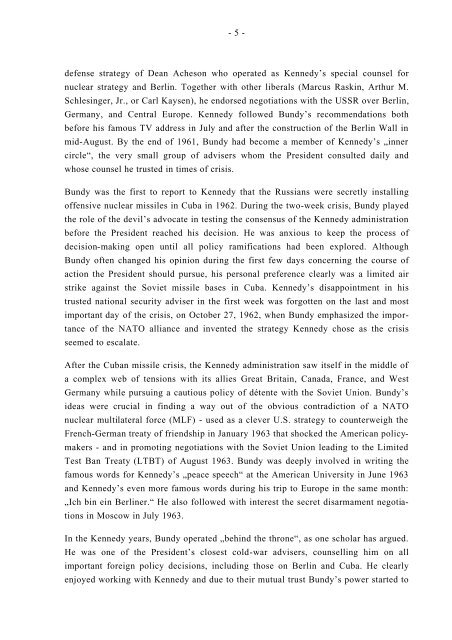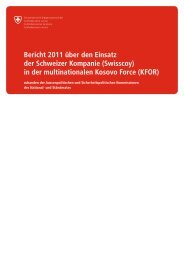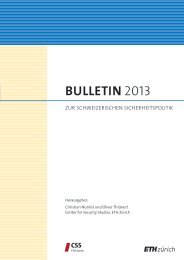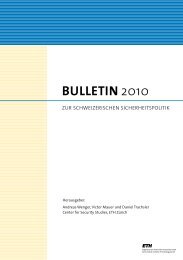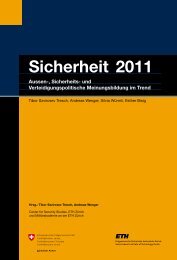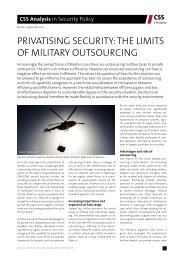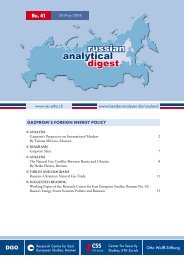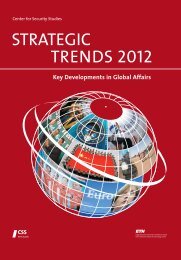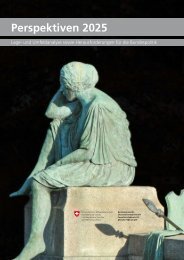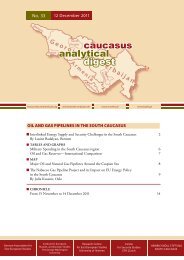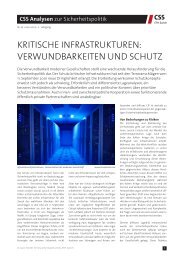German (PDF) - Center for Security Studies (CSS)
German (PDF) - Center for Security Studies (CSS)
German (PDF) - Center for Security Studies (CSS)
Erfolgreiche ePaper selbst erstellen
Machen Sie aus Ihren PDF Publikationen ein blätterbares Flipbook mit unserer einzigartigen Google optimierten e-Paper Software.
- 5 -<br />
defense strategy of Dean Acheson who operated as Kennedy’s special counsel <strong>for</strong><br />
nuclear strategy and Berlin. Together with other liberals (Marcus Raskin, Arthur M.<br />
Schlesinger, Jr., or Carl Kaysen), he endorsed negotiations with the USSR over Berlin,<br />
<strong>German</strong>y, and Central Europe. Kennedy followed Bundy’s recommendations both<br />
be<strong>for</strong>e his famous TV address in July and after the construction of the Berlin Wall in<br />
mid-August. By the end of 1961, Bundy had become a member of Kennedy’s „inner<br />
circle“, the very small group of advisers whom the President consulted daily and<br />
whose counsel he trusted in times of crisis.<br />
Bundy was the first to report to Kennedy that the Russians were secretly installing<br />
offensive nuclear missiles in Cuba in 1962. During the two-week crisis, Bundy played<br />
the role of the devil’s advocate in testing the consensus of the Kennedy administration<br />
be<strong>for</strong>e the President reached his decision. He was anxious to keep the process of<br />
decision-making open until all policy ramifications had been explored. Although<br />
Bundy often changed his opinion during the first few days concerning the course of<br />
action the President should pursue, his personal preference clearly was a limited air<br />
strike against the Soviet missile bases in Cuba. Kennedy’s disappointment in his<br />
trusted national security adviser in the first week was <strong>for</strong>gotten on the last and most<br />
important day of the crisis, on October 27, 1962, when Bundy emphasized the importance<br />
of the NATO alliance and invented the strategy Kennedy chose as the crisis<br />
seemed to escalate.<br />
After the Cuban missile crisis, the Kennedy administration saw itself in the middle of<br />
a complex web of tensions with its allies Great Britain, Canada, France, and West<br />
<strong>German</strong>y while pursuing a cautious policy of détente with the Soviet Union. Bundy’s<br />
ideas were crucial in finding a way out of the obvious contradiction of a NATO<br />
nuclear multilateral <strong>for</strong>ce (MLF) - used as a clever U.S. strategy to counterweigh the<br />
French-<strong>German</strong> treaty of friendship in January 1963 that shocked the American policymakers<br />
- and in promoting negotiations with the Soviet Union leading to the Limited<br />
Test Ban Treaty (LTBT) of August 1963. Bundy was deeply involved in writing the<br />
famous words <strong>for</strong> Kennedy’s „peace speech“ at the American University in June 1963<br />
and Kennedy’s even more famous words during his trip to Europe in the same month:<br />
„Ich bin ein Berliner.“ He also followed with interest the secret disarmament negotiations<br />
in Moscow in July 1963.<br />
In the Kennedy years, Bundy operated „behind the throne“, as one scholar has argued.<br />
He was one of the President’s closest cold-war advisers, counselling him on all<br />
important <strong>for</strong>eign policy decisions, including those on Berlin and Cuba. He clearly<br />
enjoyed working with Kennedy and due to their mutual trust Bundy’s power started to


